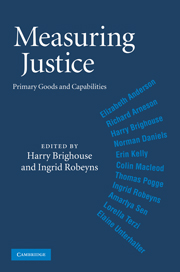Book contents
- Frontmatter
- Contents
- List of contributors
- Acknowledgments
- 1 Introduction: Social primary goods and capabilities as metrics of justice
- PART I THEORY
- PART II APPLICATIONS
- 6 Capabilities, opportunity, and health
- 7 What metric of justice for disabled people? Capability and disability
- 8 Primary goods, capabilities, and children
- 9 Education for primary goods or for capabilities?
- 10 Gender and the metric of justice
- PART III CONCLUDING ESSAY
- Index
- References
7 - What metric of justice for disabled people? Capability and disability
Published online by Cambridge University Press: 05 June 2012
- Frontmatter
- Contents
- List of contributors
- Acknowledgments
- 1 Introduction: Social primary goods and capabilities as metrics of justice
- PART I THEORY
- PART II APPLICATIONS
- 6 Capabilities, opportunity, and health
- 7 What metric of justice for disabled people? Capability and disability
- 8 Primary goods, capabilities, and children
- 9 Education for primary goods or for capabilities?
- 10 Gender and the metric of justice
- PART III CONCLUDING ESSAY
- Index
- References
Summary
In the 1979 Tanner lecture “Equality of What?” Amartya Sen formulates his well-known critique of John Rawls's conception of equality for failing to respond appropriately to the position of disabled people (Sen 1980). In Sen's view, disabled people are not equally considered by the Rawlsian metric of justice, since their difference in the conversion of primary goods, or general resources, into valuable functionings is fundamentally missed by a framework which excludes any consideration of human heterogeneity. In so doing, Sen maintains, the primary goods metric fails to account for important inequalities among individuals, and it is therefore a limited measure of egalitarian justice.
In response, John Rawls reaffirms the validity of his position by emphasising that social primary goods refer to a conception of individuals' standard endowments, and are therefore flexible enough to respond to a wide range of people's average needs. The framework of justice as fairness, Rawls argues, is intentionally formulated without considering extreme situations, such as disability, which should be addressed at a further stage of analysis (Rawls 2001, pp. 168–76).
The case of disability is indeed paradigmatic of the ongoing debate between proponents of the two main current metrics of justice: the social primary goods, or resourcist approach, and the capability approach.
- Type
- Chapter
- Information
- Measuring JusticePrimary Goods and Capabilities, pp. 150 - 173Publisher: Cambridge University PressPrint publication year: 2010
References
- 20
- Cited by



